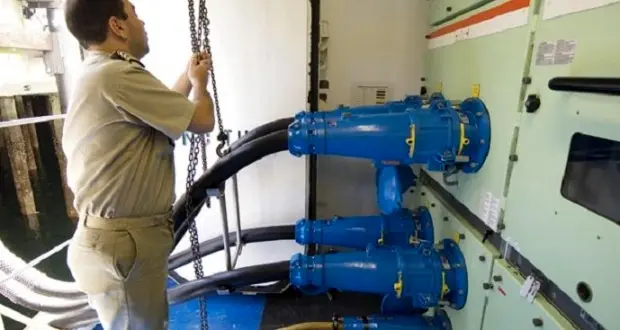Shore-to-Ship power applications

TIN news: Roberto Bernacchi, Shore-to-ship power & Smart Ports Global Product Manager, ABB, gave a presentation regarding the “Shore-to-Ship power applications”. As he explained, commercial ports are complex systems where goods and passenger traffic must be managed efficiently and in a sustainable way: all ports stakeholders, and amongst those terminal operators, shipowners and authorities, shall cooperate to achieve the lowest environmental impact, in order to be a role model for the communities in which they operate.
In view of the above, Mr. Bernacchi highlighted that, amongst the top priorities for enhancing port competitiveness and recognition, an important role is played by the management of air quality, energy efficiency and noise management. Therefore, he said, the answer to those basic needs comes with port electrification and supplying vessels with shore power during their stay at berth.
Shore-to-ship power and smart ports are highly related topics. Because ports and ships are connected, it is important to find a way to address the change that regulation brings into the market. A smart port requires a smart grid as well as other changes in its daily operations taking into account for example that nowadays, a hybrid vessel is not just a concept, but also a reality. All the sustainable transportation options (i.e. hybrid vessels, e-vehicles, shore-to-ship power) require an advanced electrical infrastructure that changes the conventional port grid, making the port ‘smart’. Therefore, it is important to offer to all stakeholders – shipowners, ports and communities – solutions which are lowering the environmental impact and enhance the sustainability of the shipping industry.
In my opinion, there are three important characteristics for a smart port, that shall be:
- Competitive: Become market leaders and Maximize return on investment
- Efficient: Add more capacity and Ensure smooth operations
- Green: Minimize energy consumption and Achieve highest levels of pollution reduction
Nowadays, ports require a smart grid instead of a traditional one. Smart grid offers centralized and distributed generation; multi-directional power flow; intermittent renewable generation; consumption integrated in system operation and operation based on real-time data. Key technologies enable better source utilization, enhance sustainability and result in active customer involvements, new business models, energy efficiency making the port greener.
Considering that new consumers are entering ports, ports should become smart to manage demand and supply. Specifically, on the one hand, we have new demand for e-mobility market (e-vehicles and e-buses), shore-to-ship power and even hybrid and full electrical ferries are now reality therefore a state-of-the-art Port Electrification infrastructure can simultaneously supply shore power to vessels and to e-mobility recharging solution. On the other hand, we can supply renewables and produce electricity on-shore which is more efficient than onboard generation. In addition, there is a portfolio of solutions that industry can offer to support grid integration.
Shore-to-ship power is one key element for port sustainability; electrical solution shall be used to lower emissions from vessels docked in ports. Auxiliary engines run by ships in port produce a large quantity of pollutants SOx, NOx, CO2, Particle discharge and increase noise levels and vibrations. Taking into account the ECAs implementation concerning SOx and the MRV regulation for CO2 emissions, solutions are needed to enhance sustainability at ports as well. Shore-to-ship power is an easy solution as we basically plug the vessel into an onshore power source. The ship’s power load is transferred to the shoreside power supply without disruption to onboard services and emissions to the local surroundings are eliminated. Shore connection is also known as Cold ironing, Onshore power supply, Alternative Maritime Power supply (AMP), etc. This technology includes many potential economic and environmental benefits. Apart from reducing pollution, noise and vibrations at ports, it also results in low operating costs for shipowners. Many technical solutions are readily available but first we need to consider the vessel type and its route (to estimate vessel’s waiting time at the port) in order to define in collaboration with all stakeholders the best approach. The key issue is not the technology itself but the planning. A ‘Synergy’, an effective collaboration is essential to enhance sustainability at ports in order to become a better place to live harmoniously and be satisfied all stakeholders i.e. ports operators, shipowners, regional government, local communities, technology suppliers and port authorities.















![AIRBUS A380 [MORE THAN 600 PASSENGER’S CAPACITY PLANE]](https://cdn.tinn.ir/thumbnail/4jCp4EQvCU0b/IjHVrSYQrIAqIzXuTzADR7qLYX4idQT4nfq__26E5SCUPLMqfhWkWajvuO9Wfq1ql1TjV4dhkrHliNQU82kMpo2NNftT_NGEwHc9KXtN_rk731bmifa2IQ,,/airbus-a380-structure1.jpg)

Send Comment